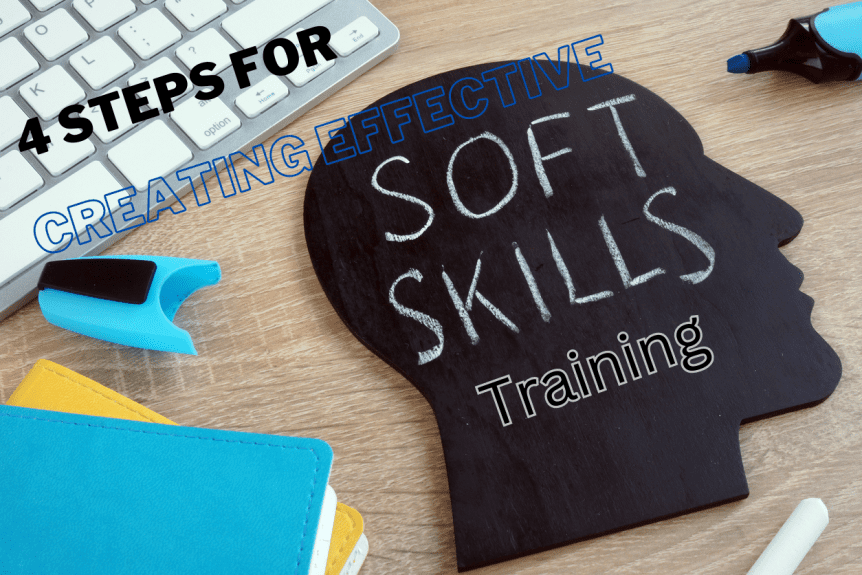4 Steps for Creating Effective Soft Skills Training
While it is understandable there is considerable focus on hard skills training and development, modern, forward-thinking organisations also realise the importance of soft skills. This means there is a need for soft skills training to bring employees up to an acceptable standard and set your organisation apart from the competition.
There are many different ways of developing and implementing a soft skills training programme. In this blog, we’ll focus on using e-learning as the soft skills training delivery method. E-learning is the ideal fit for soft skills training as learners can complete the training in a safe space at a time that suits them. It is also easy for you to customise the training to make it as relevant to your organisation as possible.
What Are Soft Skills?
Soft skills are personal qualities, habits, and social attributes that enable individuals to work well with others, communicate effectively, and adapt to changing circumstances. They are often contrasted with hard or technical skills, which are specific, job-related abilities such as programming or accounting.
What is Soft Skills Training?
Soft skills competency levels can vary greatly from person to person, so training aims to raise competency levels across your teams to an acceptable standard. Training on soft skills topics can also increase the confidence of employees and encourage them to step outside their comfort zones in a way that adds value to the business.
Most Commonly Required Soft Skills
- Communication – the ability to communicate effectively is crucial in the workplace. This includes the ability to listen actively, convey information clearly, and respond appropriately to feedback.
- Collaboration – businesses in the UAE and Saudi Arabia often require employees to work in teams, so the ability to collaborate effectively is essential. This includes being able to compromise, show respect for other opinions, and work towards a common goal.
- Adaptability – the business world is constantly evolving, so employees need the ability to adapt to changes quickly. This includes being able to learn new skills, embrace new technologies, and work in different environments.
- Problem-solving – businesses and their customers often face challenges and obstacles, so employees need to be able to solve problems efficiently and effectively. This includes the ability to think creatively, analyse information, and make informed decisions.
- Time management – given the fast-paced nature of modern workplaces, employees need to manage their time effectively. This includes prioritising tasks, meeting deadlines, and working efficiently.
- Leadership – businesses need employees who can lead and inspire others. This includes communicating a clear vision, motivating others, and making decisions that benefit the team as a whole.
- Emotional intelligence – emotional intelligence involves being aware of and managing one’s own emotions, as well as being able to understand and respond to the emotions of others.
Steps for Developing Soft Skills Training
Step 1: Identify the Soft Skills Most Important to Your Business
- Review your business goals to identify the skills your employees need to achieve those goals.
- Analyse job descriptions in your business to identify the skills that are required for each role. This will identify hard skills, but soft skills are also often included.
- Consult with your employees and their managers as both are valuable resources when it comes to identifying the skills that are most important to your business. Ask them about the skills they think are essential to their roles and the business as a whole.
Step 2: Identify Skills Gaps and Decide Topics
The next step is to identify and grade the skills gaps in your organisation. This involves analysing the skills of your employees and matching those with the skills you identified in the first step, i.e., the skills most important to your business.
There are three main ways to identify the highest priority skills gaps:
- Ask employees about the soft skills they would like to see improved, both in relation to themselves and their colleagues.
- Ask managers about the soft skills they think could be improved in their team.
- Conduct assessments to check the competency levels of employees. You can do this through a questionnaire, for example, a quiz, or an e-learning-based scenario assessment.
Once you have identified the skills gaps that currently exist, you then need to prioritise them so you can decide on the e-learning training topics that you will create.
Step 3: Create Soft Skills E-Learning Courses
This step involves creating the training. There are off-the-shelf soft skills training courses available, but it is always better to have a customised solution. Learners are more engaged with training that they can relate to because it has been tailored to make it relevant to their everyday experiences and the realities of operations in your business.
Therefore, it’s important to identify the right partner to create your customised soft skills e-learning courses. You then need to make the training as engaging and relevant as possible with scenarios and other training tools, as well as various forms of media.
Step 4: Follow-Up and Feedback
The final step is to ensure you follow up and provide feedback to learners. Speaking to managers is an important part of this process to ascertain whether employees are using the skills and information they have learned. You might also need to provide refresher courses as well as training opportunities for those who want to develop appropriate soft skills even further. More advanced leadership training is one example.
Whatever the Approach, Don’t Neglect Soft Skills
The above steps outline a highly effective strategy for developing soft skills training and raising levels of competency in your business. Whatever approach you take, the most important message is to make sure you don’t neglect soft skills training. Even the best, most highly trained, and experienced members of staff can benefit from soft skills training, so it should be part of your overall strategy.
